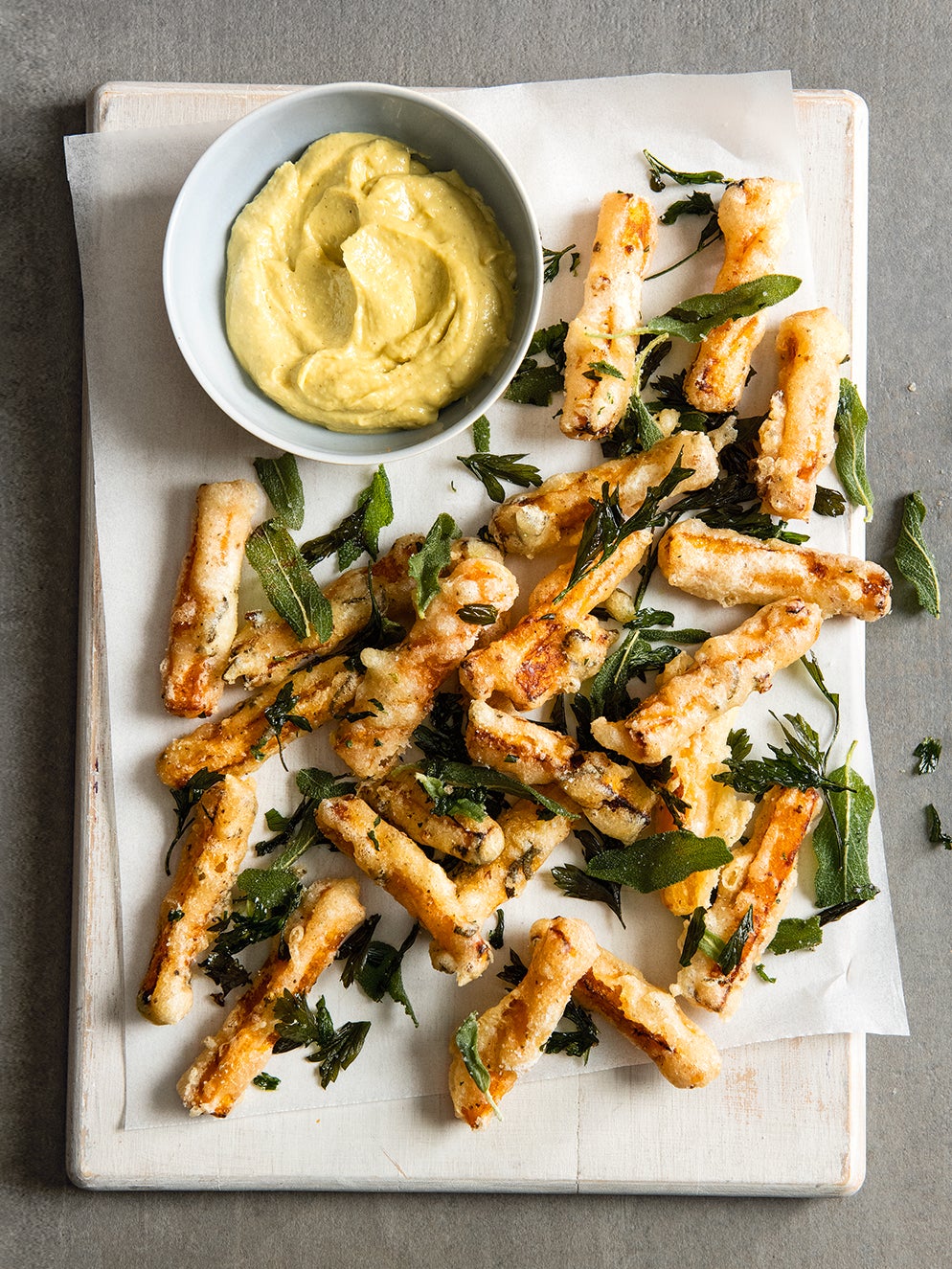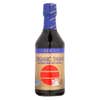A NYC Chef’s Flavor-Building Pantry Staples, None of Which Are Olive Oil
Plus recipes that star the ingredients.
Updated Oct 12, 2018 4:01 AM
We may earn revenue from the products available on this page and participate in affiliate programs.
Chef Dan Kluger knows a thing or two about flavor. He cut his teeth under the helm of Danny Meyer in the early days of Union Square Cafe and introduced the concept of farm-to-table at New York City institution ABC Kitchen alongside Jean-Georges Vongerichten, before opening his own restaurant, Loring Place, in Greenwich Village in 2014.
There, the salmon sashimi with kohlrabi, mint, and sesame chili oil is such a flavor bomb, and a simple grain salad leaves a lasting impression thanks to a smoked chili aioli. Serrano and cayenne peppers are a staple in Kluger’s kitchen. “I always have a few kinds on hand,” he says. “They not only add heat and a variety of flavors, but they can also add texture and crunch to a dish.” It’s no surprise his first cookbook, out this month, is called Chasing Flavor.
Of course, he always has basic staples on hand: kosher salt, local honey, and a collection of vinegars. But these four pantry items, he says, are what will take your dishes to the next level.
Miso
Use it in: Butternut Squash Fries With Lemon-Parmesan Aioli Serves 6-8
The takeaway: When I serve guests this appetizer, they always ask, “What’s in the aioli?” When I list the ingredients, they can’t believe how simple it is. The secret is the miso: Not only does it add richness (and eliminate the need for eggs or mayonnaise) but it adds a depth of flavor you can’t quite place. A ton of grated Parmesan also helps. Here, it’s the perfect accompaniment for crispy fried squash or any other vegetable you want to swap in—I’d start with asparagus, zucchini, or green beans.
For the lemon-Parmesan aioli Finely grated zest of 4 lemons ½ cup fresh lemon juice 2 tbsp champagne or white wine vinegar ¼ cup plus 2 tsp yellow miso paste 3 cups finely grated Parmesan cheese 4 tsp chopped rosemary 1½ tsp kosher salt 1 tsp freshly ground black pepper ½ cup extra virgin olive oil
In a blender, combine the lemon zest and juice, vinegar, miso, Parmesan, rosemary, salt, and black pepper. Blend until very smooth. With the blender running, slowly add the olive oil. Refrigerate until ready to use; the aioli can be made up to two days ahead.
For the butternut squash fries Canola or peanut oil, for frying ¾ cup all-purpose flour, plus 1 cup for dredging ¾ cup cornstarch ½ cup vodka ½ cup seltzer water Roasted butternut squash Kosher salt ¼ cup finely chopped parsley
Heat 2 inches of oil in a medium saucepan until it reaches 375 degrees Fahrenheit on a deep-fry thermometer.
In a medium bowl, whisk together the ¾ cup flour and the cornstarch. Combine the vodka and seltzer in a mixing cup and whisk the liquid into the dry ingredients until smooth.
Place the remaining flour in a shallow bowl. Working in batches, dredge the roasted squash in the flour, then dip in the batter, letting the excess drip off. Fry the squash in batches, stirring frequently, for 1½ to 2 minutes, until crisp (the batter will not brown very much). Transfer the fried squash to paper towels and sprinkle with salt and chopped parsley. Let the oil return to 375 degrees between batches.
To serve, transfer the squash to a platter and serve with the lemon-Parmesan aioli on the side.
Kombu
Use it in: Fluke Sashimi With Dried Tomatoes, Strawberries, and Olives Serves 4
The takeaway: I use kombu, a type of dried, edible kelp, to flavor stocks and other cooking liquids, as well as for quick-cured fish [like this one].
For the quick-cured fluke 10 oz skinless very fresh fluke 2 sheets kombu
Place the fluke between the sheets of kombu, then wrap in plastic and refrigerate for 2 to 4 hours (the kombu will soften as the fish cures). Discard the kombu, and thinly slice the fish across the grain.
For the strawberry-olive dressing 2 cups whole strawberries (preferably smaller ones) ¼ cup chopped Sevillano or Castelvetrano olives ¼ cup chopped kalamata olives ½ cup halved cherry tomatoes ¼ extra virgin olive oil ¼ cup fresh lime juice 1 tbsp elderflower syrup or 1½ tsp honey 2½ tsp kosher salt
Preheat oven to 200 degrees Fahrenheit and line a rimmed baking sheet with parchment paper. Measure 1½ cups of strawberries and cut them in half. Arrange the halved strawberries in a single layer on one-third of the baking sheet. Arrange all the chopped olives in a single layer on one-third of the baking sheet, and the tomatoes on the remaining section. Bake until the ingredients are shriveled and mostly dried (but still have some chew), 1 to 2 hours. Set the dehydrated strawberries aside for garnishing the dish. Place the dehydrated olives and tomatoes in a bowl.
Using the large holes of a box grater, grate the remaining ½ cup strawberries (you should have ¼ cup). Add to the dehydrated olives and tomatoes along with the oil, lime juice, elderflower syrup, and kosher salt, and stir well. The dressing can be made a few hours ahead of time, but is best used the same day.
Season one side of the fluke with kosher salt. Arrange the fish, seasoned side down, on a serving plate. Spoon the dressing over the fish and sprinkle with flaky salt. Sprinkle the dehydrated strawberries over and serve.
Elderflower Syrup
Use it in: Roasted Cauliflower With Peach-Apricot Puree and Nut Vinaigrette Serves 4-6
The takeaway: If I have a secret ingredient for salad dressings, it’s elderflower syrup, which has a flowery aroma and honey-like flavor.
For the peach-apricot puree 4 tsp sunflower or vegetable oil ¾ tsp yellow mustard seeds One 1-inch piece ginger, peeled and thinly sliced ½ Thai chile (with seeds) 1 large peach, peeled and diced 7 dried apricots, chopped 3 tbsp fresh grapefruit juice 4 tsp white wine vinegar 1¼ tsp kosher salt 2 tbsp plus 2 tsp fresh lime juice 1½ tsp elderflower syrup or ¾ tsp light honey
In a small saucepan, heat the sunflower oil over medium-low heat. Add the mustard seeds and cook, stirring, for 2 minutes. Add the ginger, chile, peaches, apricots, grapefruit juice, vinegar, and salt. Bring to a simmer over low heat, cover, and cook until the peaches are tender, 10 to 12 minutes. Transfer to a blender or mini food processor and add the lime juice and elderflower syrup. Puree until smooth. The puree can be made up to one day ahead and refrigerated until ready to use.
For the nut vinaigrette ½ cup extra virgin olive oil 1½ tsp coriander seeds, crushed ¼ cup pistachios, roughly chopped 3 tbsp sunflower seeds ½ tsp kosher salt 4 dried apricots, cut into ⅛-inch dice 2 tbsp fresh orange juice 1 tbsp fresh lemon juice
In a medium skillet, heat the oil over medium-high heat. Add the coriander, and toast until fragrant, about 2 minutes. Add the pistachios, sunflower seeds, and salt, and cook, stirring, until golden brown, about 2 minutes. Transfer the contents of the skillet to a food processor and pulse a few times, until the nuts are roughly chopped. Transfer to a bowl and stir in the apricots, orange juice, and lemon juice. The nut vinaigrette can be made up to one day ahead and refrigerated until ready to use.
For serving 1 medium head cauliflower ¼ cup extra virgin olive oil, plus more for drizzling Kosher salt and freshly ground black pepper ½ cup peach-apricot puree Nut vinaigrette 2 tbsp finely chopped tarragon 2 tbsp thinly sliced mint ½ red finger chile, thinly sliced into half moons 1 orange, for zesting Flaky sea salt
Preheat oven to 400 degrees Fahrenheit. Remove the outer leaves from the cauliflower and set the head, stem side down, on a cutting board. Cut the cauliflower from top to bottom into ¾-inch-thick slices. You should be able to get a couple of large steaks out of the middle of the cauliflower and some smaller pieces from the outsides.
Heat the olive oil in a large skillet over medium-high heat. Working in batches if necessary, season the cauliflower with salt and pepper, and add to the skillet. Sear on one side until deeply golden brown, about 5 minutes, then flip and continue cooking until the other side is well browned, about 5 minutes longer. Transfer to a rimmed baking sheet. Roast until the cauliflower is tender, 15 to 20 minutes.
Spread the peach-apricot puree on the bottom of a serving platter. Arrange the cauliflower pieces over, and drizzle with the nut vinaigrette. Sprinkle with the tarragon, mint, and chile; drizzle with olive oil; and grate some orange zest over the top. Season with flaky salt and serve.
Tamari
Use it in: Little Gem Salad With Sesame-Soy Dressing and Crispy Shallots Serves 4
The takeaway: The dressing is based on that classic Japanese combination of soy sauce, rice vinegar, and sesame oil, which is aggressive enough to stand up to the Little Gems and other heartier greens. Because many of our guests avoid gluten, I use tamari instead of soy sauce, which contains wheat.
For the crispy shallots 2 large shallots, peeled and thinly sliced into rings, about ½ cup 2 cups vegetable or canola oil
Place the shallots in a medium saucepan and cover with the oil. Place over medium heat and cook, stirring constantly, until the shallots are light golden brown. Pour the shallots and oil through a fine-mesh strainer and gently press with a spoon or ladle to squeeze out all of the oil. The shallots will continue to cook, so work quickly. Spread the shallots out on paper towels (they will crisp up as they cool). The shallots can be made up to one week ahead; store in an airtight container.
For the sesame-soy dressing ¼ cup fresh lemon juice 4 tsp tamari or soy sauce 4 tsp rice vinegar 1 tsp sesame oil 1 tsp kosher salt 1 tsp honey ½ cup extra virgin olive oil
Combine all ingredients in a blender and blend until smooth.
For serving 4 heads Little Gem lettuce, rinsed and shaken dry ½ cup sesame-soy dressing ¼ cup finely chopped mint ¼ cup finely chopped basil ½ cup crispy shallots 1 red finger chile, thinly sliced Coarsely ground black pepper
Trim ¼ inch from the root ends of the lettuce heads, leaving the head intact. Place one head of lettuce, root side down, in a small serving bowl and spread the leaves apart to open the lettuce like a blossom. Repeat with the remaining lettuce. Drizzle about 2 tablespoons dressing over each head of lettuce. Sprinkle one-quarter of the herbs, shallots, and chile over each head of lettuce, and finish each with a couple grinds of black pepper. Serve.
Our Fall Style issue has arrived! Subscribe now to get an exclusive first look at Ayesha Curry’s Bay Area home—and discover how design can shape our world.








